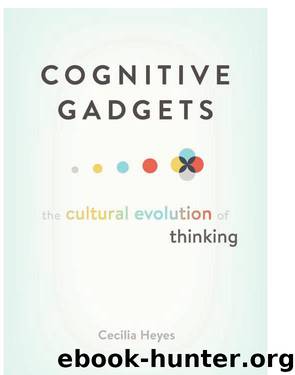Cognitive Gadgets by Cecilia Heyes

Author:Cecilia Heyes
Language: eng
Format: epub
Published: 2018-03-05T05:53:32+00:00
Mindreading 159
Familiarization
First
A
B
Second
Test
False Belief 1
C
D
False Belief 2
7.1 Stills from the videos used by Southgate and colleagues to test for the
ascription of false beliefs by twenty-five- month- old infants. (Reprinted with
permission from Southgate, Senju, and Csibra, 2007.)
160
C O G N I T I V E G A D G E T S
more specifically, “inattentional blindness” (Mack and Rock, 1998).
Like adults who fail to notice a gorilla in a group of humans because
they are focused on a counting task (Simons and Chabris, 1999), the
infants may have failed to notice the ball movements while the bell
was ringing because their attention was focused on the agent’s turned
head and the area to which she was looking. Thus, the infants made
their first eye movements to the last location at which they, the infants, had seen the ball: to the right box in False Belief 1, the condition in which the agent turned after the ball was transferred from left to right, and the left box in False Belief 2, the condition in which the
agent turned after the ball was initially placed in that left box.2
The evidence of implicit mindreading in nonhuman apes could
also be due to domain general pro cessing (Heyes, 2015). For example,
Krupenye and colleagues used a procedure modeled on the study
by Southgate and colleagues (2007), described above, to test for false
belief ascription in chimpanzees, bonobos, and orangutans (Krupenye, Kano, Hirata, Call, and Tomasello, 2016). In their experiment, the agent, rather than turn away, left the scene during critical movements of the target object. This was an advantage in that it allowed the apes, unlike the infants, to view the object movements without distraction. However, it had the unfortunate side effect of making the agent, who wore a bright green shirt, into an ideal retrieval cue, that is, a stimulus that triggers recall of an event
because it was prominent when the event was encoded. The apes
may have seen the target object at each location but, guided in the
test by the pattern established during familiarization trials, retrieved from memory the location at which it last appeared with the bright green stimulus (Heyes, 2017b).
Mindreading can be distinguished from domain general processing using inanimate control procedures, in which social stimuli are replaced by non social stimuli with similar low level perceptual
Download
This site does not store any files on its server. We only index and link to content provided by other sites. Please contact the content providers to delete copyright contents if any and email us, we'll remove relevant links or contents immediately.
Rewire Your Anxious Brain by Catherine M. Pittman(17600)
Talking to Strangers by Malcolm Gladwell(11906)
The Art of Thinking Clearly by Rolf Dobelli(8862)
Mindhunter: Inside the FBI's Elite Serial Crime Unit by John E. Douglas & Mark Olshaker(7849)
Becoming Supernatural by Dr. Joe Dispenza(7120)
Change Your Questions, Change Your Life by Marilee Adams(6655)
The Road Less Traveled by M. Scott Peck(6647)
Nudge - Improving Decisions about Health, Wealth, and Happiness by Thaler Sunstein(6643)
The Lost Art of Listening by Michael P. Nichols(6481)
Enlightenment Now: The Case for Reason, Science, Humanism, and Progress by Steven Pinker(6414)
Win Bigly by Scott Adams(6328)
Mastermind: How to Think Like Sherlock Holmes by Maria Konnikova(6250)
The Way of Zen by Alan W. Watts(5809)
Daring Greatly by Brene Brown(5651)
Grit by Angela Duckworth(4747)
Big Magic: Creative Living Beyond Fear by Elizabeth Gilbert(4734)
Men In Love by Nancy Friday(4341)
Flow by Mihaly Csikszentmihalyi(4061)
The Four Tendencies by Gretchen Rubin(4030)
